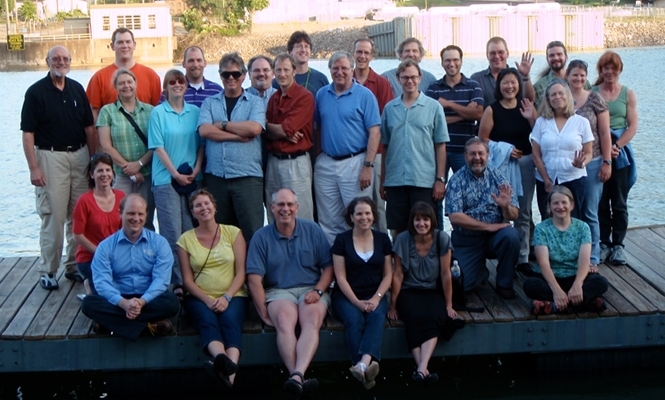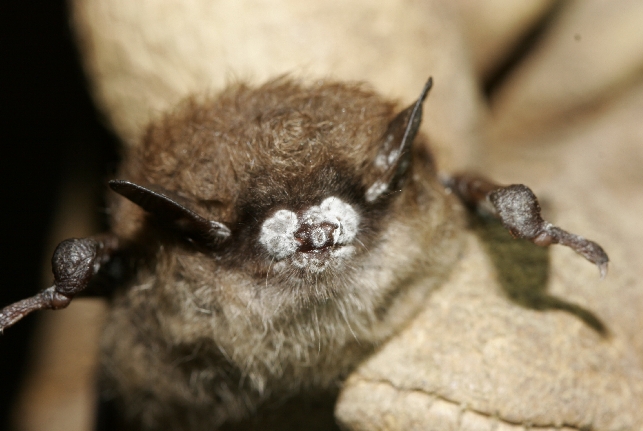| Description | Participants | Agenda | Summary | Products | Feature Article |
|---|
NIMBioS Investigative Workshop
Modeling White Nose Syndrome in Bats

Topic: Modeling White Nose Syndrome (WNS) in Bats at the Individual and Colony Levels: Epizootiology and Management
Meeting dates: June 29 - July 1, 2009
Organizers:
Thomas G. Hallam
(Dept. of Ecology & Evolutionary Biology, Univ. of Tennessee, Knoxville)
Gary F. McCracken
(Dept. of Ecology & Evolutionary Biology, Univ. of Tennessee, Knoxville)
Objectives. The epizootiology of White Nose Syndrome (WNS) in bats is best described as partially understood. Indeed, there are uncertainties and questions about the pathogenesis of the disease although it is understood that the fungi Geomyces sp. play a significant role in the onset and progression of the disease. The purpose of this workshop was to develop modeling directions to help assist in the understanding of the temporal and spatial scales, the pathology, and the physiology of bats during WNS stress and ultimately to lead to managed control of the disease.
Evaluation report (PDF)
 Summary Report.
The NIMBioS Investigative Workshop on White Nose Syndrome in Bats (WNS) was held on June 30 – July 2, 2009 with 37 participants from all over the United States. The participants included a diverse array of academicians (primarily theoreticians and biologists), wildlife managers from NGOs, and state and federal government representatives. The focus of the workshop was to understand and mitigate WNS, which is now recognized as the major threat to bats in North America. The workshop was preceded by a webinar held on June 25 featuring 12 speakers who provided background materials necessary for the workshop. The workshop itself consisted of breakout discussion groups that focused on specialized topics and themes, and plenary discussions that focused on results and mitigation needs. Breakout discussion sessions included modeling and fungi, modeling and bat ecology relevant to WNS, modeling perspectives and utility to WNS, and modeling and management.
Summary Report.
The NIMBioS Investigative Workshop on White Nose Syndrome in Bats (WNS) was held on June 30 – July 2, 2009 with 37 participants from all over the United States. The participants included a diverse array of academicians (primarily theoreticians and biologists), wildlife managers from NGOs, and state and federal government representatives. The focus of the workshop was to understand and mitigate WNS, which is now recognized as the major threat to bats in North America. The workshop was preceded by a webinar held on June 25 featuring 12 speakers who provided background materials necessary for the workshop. The workshop itself consisted of breakout discussion groups that focused on specialized topics and themes, and plenary discussions that focused on results and mitigation needs. Breakout discussion sessions included modeling and fungi, modeling and bat ecology relevant to WNS, modeling perspectives and utility to WNS, and modeling and management.
Recognitions and recommendations of the workshop include the following:
- Preliminary work has indicated that the pathogen is an exotic fungus, Geomyces destructans; that the epizootic emanated from a point source in a cave near Albany NY; and that the transmission of WNS is primarily bat-to-bat.
- The disease is at a critical stage in that it has spread rapidly and has disastrous effects on many species of bats.
- A primary concern for managers is the ability to scientifically predict when and where the fungus will next occur, which at present is a "best guess."
- Management has a strong need for models that can aid in decisions about mitigation of WNS. Identification of onset time of infectivity of the bats in hibernacula is of special concern for remediation actions.
- Properly formulated models can help organize the material, provide directions for experimental work, provide a synthesis of the data, and project testable conclusions about WNS on several temporal and spatial scales. Modeling should be pursued as important components of the WNS analysis and management.
WNS Plans for the Future. Immediate time scale plans include organizing groups of workshop participants to meet a July 31, 2009 deadline for proposals for a special U.S. Fish and Wildlife Service funding initiative on WNS. At this stage no modeling groups have actively pursued funding for WNS research, but with impetus from this workshop, at least one modeling proposal will address this RFP. Another group that has emerged from the workshop is exploring chemical and veterinary intervention to the spread of the disease. Plans were presented to convene a small group of modelers and biologists to organize the modeling efforts for WNS, hopefully through the auspices of NIMBioS. In August, we plan to present a proposal to NIMBioS that will form a working group on WNS. This group will be a select but diverse group including several participants from the workshop.
Products
Publications
Vulinec et al. 2017. Buckyballs and bats: trace evidence points to trophic interactions. Frontiers in Ecology and the Environment, 15: 108. [Online]
Ingersoll TE, Sewall BJ, Amelon SK. 2016. Effects of white-nose syndrome on regional population patterns of 3 hibernating bat species. Conservation Biology, 30(5): 1048. [Online]
Reynolds HT, Ingersoll TE, Barton HA. 2015. Modeling the environmental growth of Pseudogymnoascus destructans and its impact on the white-nose syndrome epidemic. Journal of Wildlife Diseases, 51(2): 318. [Online]
Souza MJ, Cairns T, Yarbrough J, Cox S. 2012. In vitro investigation of a terbinafine impregnated subcutaneous implant for veterinary use. Journal of Drug Delivery, 2012(2012): 436710. [Online]
Hallam TG, McCracken GF. 2011. Management of the panzootic white-nose syndrome through culling of bats. Conservation Biology, 25(1): 189-194. [Online]
Hallam TG, Federico P. 2011. The panzootic white-nose syndrome: an environmentally constrained disease? Transboundary and Emerging Diseases, 59(3): 269-278. [Online]
Frick WF, Pollock JF, Hicks AC, Langwig KE, Reynolds DS, Turner GG, Butchkoski CM, Kunz TH. 2010. An emerging disease causes regional population collapse of a common North American bat species. Science, 329(5992): 679-82. [Online]
Frick WF, Reynolds DS, Kunz TH. 2010. Influence of climate and reproductive timing on demography of little brown myotis Myotis lucifugus. Journal of Animal Ecology, 79(1): 128-136. [Online]
Reichard JD, Kunz TH. 2009. White-nose syndrome inflicts lasting injuries to the wings of little brown myotis (Myotis lucifugus). Acta Chiropterologica, 11(2): 457-464. [Online]
Dissertations/Thesis
Benson B. 2010. Dissertation: White nose syndrome and migration of Delaware's bats. Delaware State University.
Pannkuk EL. 2010. Dissertation: Fungal metabolism of chiropteran integument and biomechanical damage by geomyces species.
Presentations
Martinez AT et al. 16-18 April 2014. Network for integrating bioinformatics into life sciences education agenda, Omaha, Nebraska.
Souza MJ, Reeder D, Hines B, Dutkosky R, Ramsay E, Cairns T, Newkirk K, Cox S. 2013 September 3-6. Investigation of a terbinafine impregnated subcutaneous implant for the prevention or treatment of white nose syndrome in little brown bats (Myotis lucifugus). White Syndrome Symposium, Boise, ID.
Dutkosky R, Newkirk K, Reeder D, Ramsay E, Souza M. 2012 December. Evaluation of a terbinafine impregnated subcutaneous implant in Geomyces destructans-infected bats. Annual Conference of the American College of Veterinary Pathologists, Seattle, WA.
Souza MJ. 2012 June. Evaluation of a terbinafine impregnated implant for the prevention of white nose syndrome. White Nose Syndrome Symposium, Madison, WI.
Souza MJ, Yarbrough JW, Cox SK. June 2012. In vitro investigation of a terbinafine impregnated subcutaneous implant. White nose syndrome symposium, Little Rock, AR.
Ingersoll T. February 2011. Zero-inflated count models for imperfectly observed invasions: Implications for white-nose syndrome surveillance. 21st Colloquium on the Conservation of Mammals in the Southeast United States, Louisville, KY.
Ingersoll TE. October 2010. Accounting for seasonal effects with additive mixed models for counts of bat activity. North American Society for Bat Research, Denver, CO.
Kunz TH, Frick WF, Pollock J, Reynolds RS. February 2010. Impact of white-nose syndrome on ecosystem services provided by insectivorous bats. 2nd Berlin Bat Meeting: Bat Biology and Infectious Diseases, Berlin, Germany.
Kunz TH, Blehert DS, Cryan PM, Coleman JH, Hicks A, Tuttle MD. 2009. White-nose syndrome in hibernating bats: Are these affected bats the next "canary in the mine"? 15th International Congress of Speleology, Kerrville, TX.
Grants/Proposals
Pannkuk EL, Risch T, Savary B, Gilmore D, Huss M. 2009. Proposal: Fungal digestion of chiropteran integument. National Speleological Society. $5,800. Accepted.
Media Coverage
Crawley, C. 2011. Culling can't control deadly bat disease. Eurekalert
Sahagun, L. 2011. Fungus sweeps across the country, killing bats. Los Angeles Times
Simmons, M. 2009. White nose syndrome threatens state's bats. Knoxville News Sentinel
Simmons, M. 2009. National Forests close caves over bat disease. Knoxville News Sentinel
Other Products
Wallrichs, M. 2010. Golf Course Habitat Improvement for Bat Conservation (DE/MD) (includes monitoring for WNS). Delaware State University, Dover, DE.
NIMBioS Investigative Workshops focus on broad topics or a set of related topics, summarizing/synthesizing the state of the art and identifying future directions. Workshops have up to 35 participants. Organizers and key invited researchers make up half the participants; the remaining participants are filled through open application from the scientific community. Open applicants selected to attend are notified by NIMBioS within two weeks of the application deadline. Investigative Workshops have the potential for leading to one or more future Working Groups. Individuals with a strong interest in the topic, including post-docs and graduate students, are encouraged to apply. If needed, NIMBioS can provide support (travel, meals, lodging) for Workshop attendees, whether from a non-profit or for-profit organization.
A goal of NIMBioS is to enhance the cadre of researchers capable of interdisciplinary efforts across mathematics and biology. As part of this goal, NIMBioS is committed to promoting diversity in all its activities. Diversity is considered in all its aspects, social and scientific, including gender, ethnicity, scientific field, career stage, geography and type of home institution. Questions regarding diversity issues should be directed to diversity@nimbios.org. You can read more about our Diversity Plan on our NIMBioS Policies web page. The NIMBioS building is fully handicapped accessible.
NIMBioS
1122 Volunteer Blvd., Suite 106
University of Tennessee
Knoxville,
TN 37996-3410
PH: (865) 974-9334
FAX: (865) 974-9461
Contact NIMBioS


